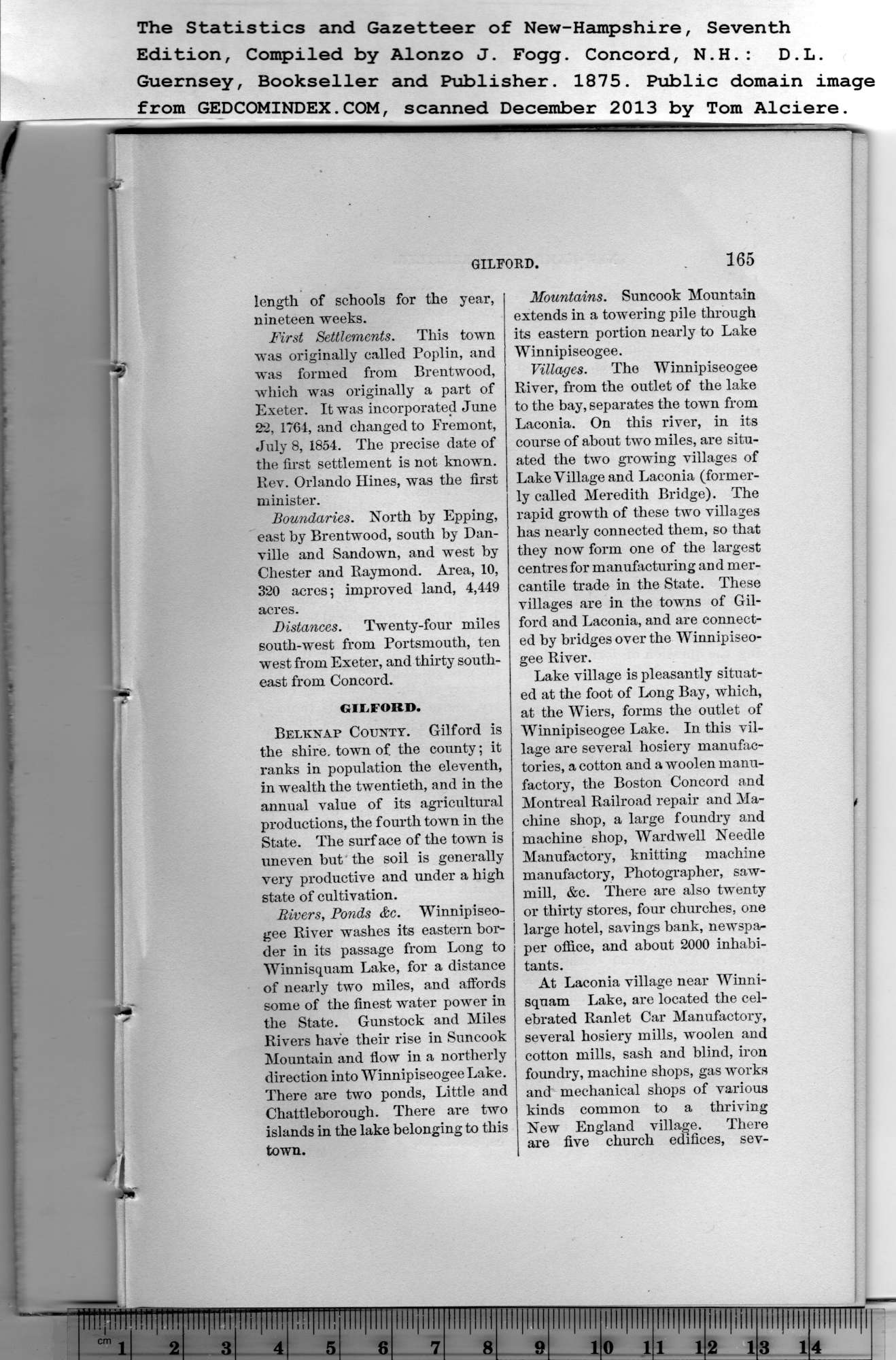|
length of schools for the year,
nineteen weeks.
First Settlements. This town
was originally called Poplin, and
was formed from Brentwood,
which was originally a part of
Exeter. It was incorporated June
22, 1764, and changed to Fremont,
July 8, 1854. The precise date of
the first settlement is not known.
Rev. Orlando Hines, was the first
minister.
Boundaries. North by Epping,
east by Brentwood, south by Dan-
ville and Sandown, and west by
Chester and Raymond. Area, 10,
320 acres; improved land, 4,449
acres.
Distances. Twenty-four miles
south-west from Portsmouth, ten
west from Exeter, and thirty south-
east from Concord.
GILFORD.
Belknap County. Gilford is
the shire, town of the county; it
ranks in population the eleventh,
in wealth the twentieth, and in the
annual value of its agricultural
productions, the fourth town in the
State. The surf ace of the town is
uneven but the soil is generally
very productive and under a high
state of cultivation.
Rivers, Ponds &c. Winnipiseo-
gee River washes its eastern bor-
der in its passage from Long to
Winnisquam Lake, for a distance
of nearly two miles, and affords
some of the finest water power in
the State. Gunstock and Miles
Rivers have their rise in Suncook
Mountain and flow in a northerly
direction into Winnipiseogee Lake.
There are two ponds, Little and
Chattleborough. There are two
islands in the lake belonging to this
town.
|
Mountains. Suncook Mountain
extends in a towering pile through
its eastern portion nearly to Lake
Winnipiseogee.
Villages. The Winnipiseogee
River, from the outlet of the lake
to the bay, separates the town from
Laconia. On this river, in its
course of about two miles, are situ-
ated the two growing villages of
Lake Village and Laconia (former-
ly called Meredith Bridge). The
rapid growth of these two villages
has nearly connected them, so that
they now form one of the largest
centres for manufacturing and mer-
cantile trade in the State. These
villages are in the towns of Gil-
ford and Laconia, and are connect-
ed by bridges over the Winnipiseo-
gee River.
Lake village is pleasantly situat-
ed at the foot of Long Bay, which,
at the Wiers, forms the outlet of
Winnipiseogee Lake. In this vil-
lage are several hosiery manufac-
tories, a cotton and a woolen manu-
factory, the Boston Concord and
Montreal Railroad repair and Ma-
chine shop, a large foundry and
machine shop, Wardwell Needle
Manufactory, knitting machine
manufactory, Photographer, saw-
mill, &c. There are also twenty
or thirty stores, four churches, one
large hotel, savings bank, newspa-
per office, and about 2000 inhabi-
tants.
At Laconia village near Winni-
squam Lake, are located the cel-
ebrated Ranlet Car Manufactory,
several hosiery mills, woolen and
cotton mills, sash and blind, iron
foundry, machine shops, gas works
and mechanical shops of various
kinds common to a thriving
New England village. There
are five church edifices, sev- |
